Contents
- 1 Assignment One
- 2 Answer the following descriptive category questions in about 500 words each. Eachquestion carries 20 marks.
- 3 1. Explain the factors influencing counseling process.
- 4 2. What is person-centred therapy? Explain the techniques or strategies used in it.
- 5 3. Explain the key concepts of choice theory and describe the significance of reality therapy.
- 6 Assignment Two
- 7 Answer the following short category questions in about 100 words each. Each question carries 5 marks.
- 8 4.Explain the goals and objectives of counselling.
- 9 5. Explain the importance of informed consent and confidentiality in counselling.
- 10 6. Differentiate between assessment and testing.
- 11 7. What is free association?
- 12 8. Describe the assumptions of behavior therapy.
- 13 9. Describe the basic counseling skills.
- 14 10. What are the steps in art therapy?
- 15 11. Describe the working phases in multi-dimensional family therapy.

| Title | BPCC-114: IGNOU BAG Solved Assignment 2022-2023 |
| University | IGNOU |
| Degree | Bachelor Degree Programme |
| Course Code | BPCC-114 |
| Course Name | COUNSELLING PSYCHOLOGY |
| Programme Name | Bachelor of Arts (General) |
| Programme Code | BAG |
| Total Marks | 100 |
| Year | 2022-2023 |
| Language | English |
| Assignment Code | Asst /TMA /2022-23 |
| Assignment PDF | Click Here |
| Last Date for Submission of Assignment: | For June Examination: 31st April For December Examination: 30th September |
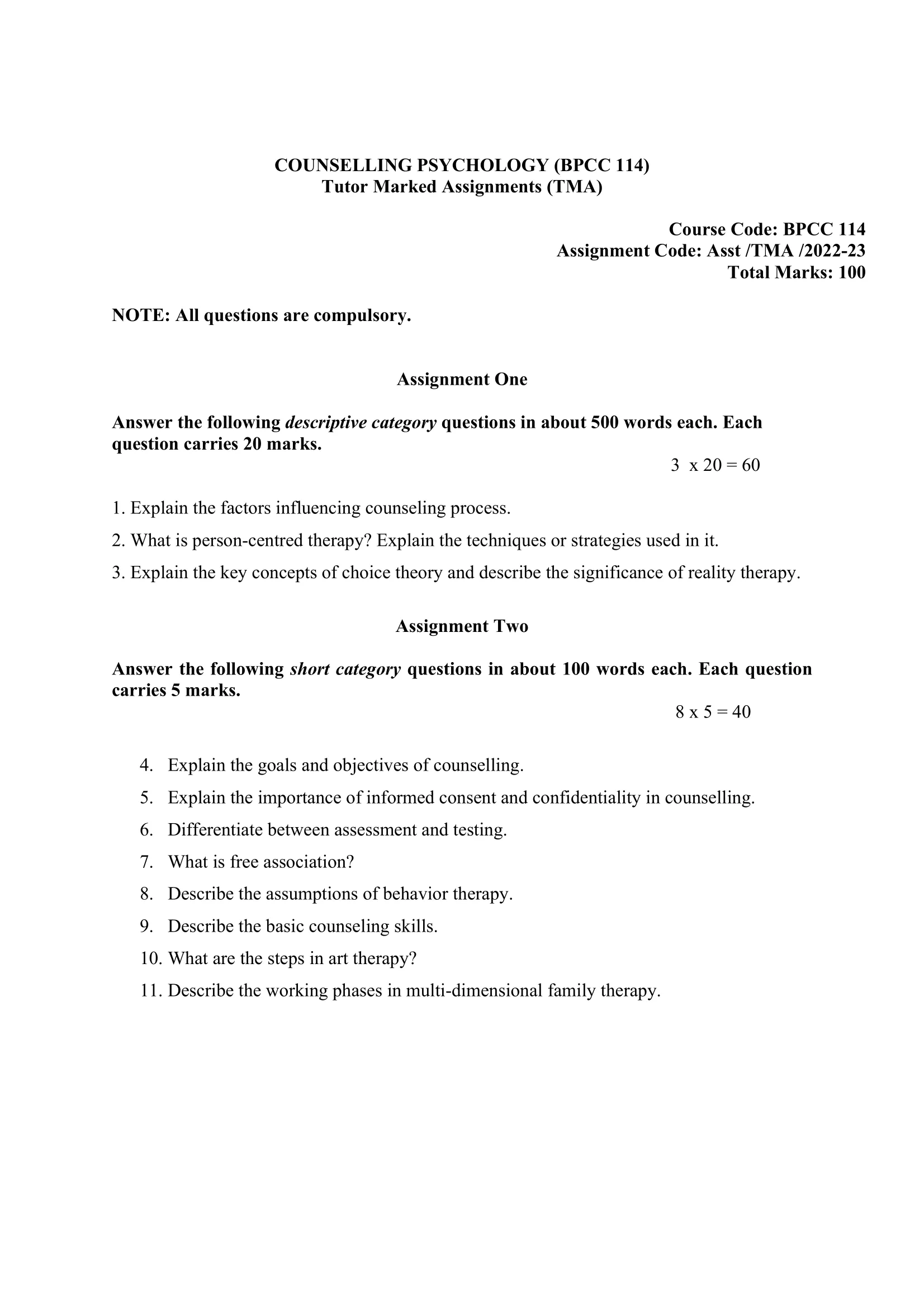
Assignment One
Answer the following descriptive category questions in about 500 words each. Each
question carries 20 marks.
1. Explain the factors influencing counseling process.
Ans: Counseling is a therapeutic process where a trained counselor or therapist provides guidance and support to an individual to help them overcome personal, social, or emotional challenges. The counseling process is complex and involves multiple factors that can influence its effectiveness. In this article, we will discuss the factors influencing the counseling process.
- Client Factors: One of the most important factors that influence the counseling process is the client’s characteristics. Factors such as age, gender, culture, religion, educational background, and socioeconomic status can affect the counseling process. For example, individuals from different cultures may have different beliefs and values, which can impact their willingness to participate in counseling. Similarly, individuals with lower socioeconomic status may have limited access to resources, making it difficult for them to attend regular counseling sessions.
- Counselor Factors: Another important factor is the counselor’s characteristics, which includes their personality, training, and experience. Counselors who possess good communication skills, empathy, and a non-judgmental attitude are more effective in establishing a good rapport with the client. Furthermore, counselors who have specialized training in a particular area of counseling are better equipped to help clients with specific issues.
- Relationship Factors: The relationship between the client and the counselor is crucial to the success of the counseling process. The client needs to trust the counselor and feel comfortable discussing their concerns with them. The counselor’s ability to establish a positive and supportive relationship with the client is vital to creating a safe space for the client to explore their thoughts and feelings.
- Contextual Factors: Contextual factors such as the setting, timing, and duration of counseling can also impact the effectiveness of counseling. For example, counseling sessions held in a comfortable and private environment can promote a sense of safety and confidentiality. The timing and duration of counseling sessions should also be appropriate to the client’s needs and circumstances.
- Client’s Motivation: The client’s motivation and readiness to engage in the counseling process also play a significant role. Clients who are highly motivated to change and improve their circumstances are more likely to benefit from counseling. However, clients who are forced to attend counseling or who are not fully committed to the process may not achieve the desired outcomes.
- Nature of the Problem: The nature of the problem that the client is facing can also affect the counseling process. Some issues such as anxiety, depression, and trauma require specialized treatment, and the counselor must have the appropriate training and experience to handle these issues effectively.
2. What is person-centred therapy? Explain the techniques or strategies used in it.
Ans: Person-centred therapy, also known as client-centred therapy or Rogerian therapy, is a form of psychotherapy developed by Carl Rogers in the 1950s. Person-centred therapy is based on the philosophy that every individual has the potential for personal growth and change. The primary goal of person-centred therapy is to provide a supportive and empathic environment in which clients can explore their feelings and experiences, gain insight into themselves, and work towards achieving their goals.
The following are the key techniques and strategies used in person-centred therapy:
- Unconditional Positive Regard: Unconditional positive regard is a fundamental concept of person-centred therapy. It refers to the therapist’s acceptance and non-judgmental attitude towards the client, regardless of their beliefs, values, or behaviors. This creates a safe and supportive environment that encourages the client to explore their thoughts and feelings without fear of rejection or criticism.
- Empathy: Empathy is the ability to understand and connect with the client’s feelings and experiences. In person-centred therapy, the therapist uses empathy to create a strong therapeutic relationship with the client, which facilitates the exploration and expression of emotions.
- Reflection: Reflection involves the therapist paraphrasing or summarizing what the client has said to help the client clarify their thoughts and feelings. This technique can help the client gain insight into their emotions and promote self-awareness.
- Active Listening: Active listening involves paying close attention to the client’s words, body language, and tone of voice to fully understand their experiences and emotions. This technique helps the therapist to respond appropriately and provide support and guidance to the client.
- Congruence: Congruence refers to the therapist’s ability to be authentic and genuine in the therapy session. The therapist is open and honest about their feelings and thoughts, creating an environment of mutual trust and respect.
- Non-Directive Approach: In person-centred therapy, the therapist takes a non-directive approach and allows the client to lead the session. This means that the therapist does not give advice or offer solutions but instead provides support and guidance as the client explores their thoughts and feelings.
- Self-Exploration: Person-centred therapy emphasizes self-exploration, and the client is encouraged to explore their feelings, thoughts, and experiences in a non-judgmental environment. Through this process, clients gain insight into themselves and develop a greater understanding of their emotions.
- Client-Centered Approach: Person-centred therapy is centered around the needs and goals of the client. The therapist works collaboratively with the client to establish therapy goals, and the therapy process is tailored to the client’s individual needs.
3. Explain the key concepts of choice theory and describe the significance of reality therapy.
Ans: Choice theory is a psychological framework developed by Dr William Glasser. It is based on the idea that individuals are in control of their own lives and their choices shape their behavior and experiences. The theory suggests that individuals have five basic needs that drive their behavior: survival, love and belonging, power, freedom, and fun. According to choice theory, individuals make choices based on these needs and their perceptions of reality.
Reality therapy, also developed by Dr William Glasser, is a type of therapy that is based on choice theory. The primary goal of reality therapy is to help individuals identify and meet their needs in a constructive and responsible way. The therapy approach emphasizes personal responsibility and the importance of making positive choices that lead to a more satisfying life.
The following are the key concepts of choice theory:
- Basic needs: According to choice theory, individuals have five basic needs that drive their behavior: survival, love and belonging, power, freedom, and fun. These needs are considered the foundation of human behavior and motivation.
- Choice: Choice is a fundamental concept of choice theory. Individuals make choices based on their perceptions of reality and their basic needs. The choices individuals make determine their behavior and the outcomes they experience.
- Quality World: The Quality World is a concept in choice theory that refers to an individual’s idealized view of the world. The Quality World includes the people, things, and experiences that individuals believe will meet their basic needs and bring them happiness and satisfaction.
- Total Behavior: Total behavior is the idea that behavior is composed of four components: thinking, feeling, physiology, and action. Each component of behavior affects the others, and all four components are considered when addressing a behavior.
- The Seven Deadly Habits: The Seven Deadly Habits are behaviors that are considered unhelpful or harmful and can prevent individuals from meeting their basic needs. These habits include criticizing, blaming, complaining, nagging, threatening, punishing, and bribing or rewarding to control.
The significance of reality therapy is that it offers a practical and solution-focused approach to therapy. Reality therapy emphasizes personal responsibility and the importance of making choices that lead to positive outcomes. The therapy approach helps individuals identify their basic needs and work towards meeting them in a responsible and constructive way. Reality therapy also places a strong emphasis on the present and future, rather than dwelling on past experiences or behaviors.
Reality therapy is particularly effective for individuals who are struggling with relationship issues, addiction, anxiety, or depression. The therapy approach helps individuals identify the choices they have made and the consequences of those choices, as well as encourages them to make more positive choices that lead to a more satisfying life. The focus on personal responsibility and choice can be empowering for individuals and help them take control of their lives.
Assignment Two
Answer the following short category questions in about 100 words each. Each question carries 5 marks.
4.Explain the goals and objectives of counselling.
Ans: The primary goal of counseling is to help individuals overcome their personal challenges, improve their mental health and wellbeing, and achieve their full potential. Counselors aim to provide a safe, supportive, and non-judgmental environment where clients can explore their thoughts, feelings, and behaviors, and develop strategies to address their concerns.
The specific objectives of counseling may vary depending on the client’s needs, but typically include the following:
- Providing emotional support and empathy: Counselors aim to help clients feel heard, understood, and validated, which can be a powerful source of comfort and healing.
- Identifying and clarifying problems: Through active listening, questioning, and reflection, counselors help clients identify the root causes of their challenges and gain clarity on their thoughts and feelings.
- Setting achievable goals: Counselors work with clients to develop realistic, achievable goals that can help them overcome their challenges and make positive changes in their lives.
- Developing coping skills and strategies: Counselors teach clients practical skills and techniques to manage their emotions, overcome obstacles, and achieve their goals.
- Promoting self-awareness and personal growth: Counselors encourage clients to reflect on their values, beliefs, and goals, and to make positive changes that align with their authentic selves.
5. Explain the importance of informed consent and confidentiality in counselling.
Ans: Informed consent and confidentiality are two critical ethical principles in counseling.
Here’s why: Informed Consent: Informed consent means that clients must receive clear and comprehensive information about the counseling process, its limitations, and its potential benefits and risks. Counselors must explain the nature of their services, their credentials and qualifications, and the limitations of confidentiality, and obtain the client’s voluntary agreement to receive services. Informed consent is essential to ensure that clients have the autonomy to make informed decisions about their mental health care, and that counselors respect their right to self-determination.
Confidentiality: Confidentiality means that information shared by the client in the counseling relationship is kept private and protected from unauthorized disclosure. Confidentiality is critical to building trust between the counselor and the client and to create a safe space where clients can feel free to share their thoughts, feelings, and experiences. Counselors have a legal and ethical obligation to protect clients’ confidentiality, except in situations where there is a risk of harm to the client or others, or where required by law or court order. Breaching confidentiality can damage the client-counselor relationship, undermine trust, and jeopardize clients’ safety.
6. Differentiate between assessment and testing.
Ans: Assessment and testing are two related but distinct processes in psychology and education. Here are the differences between the two:
Assessment: Assessment is the process of gathering information about an individual’s abilities, characteristics, and behaviors through a variety of methods, including observation, interviews, self-reports, and standardized tests. Assessment is a broad process that includes both formal and informal procedures to evaluate individuals’ strengths, challenges, and needs. The primary purpose of assessment is to obtain a comprehensive understanding of an individual’s functioning, which can inform decision-making and treatment planning.
Testing: Testing is a specific type of assessment that involves the administration of standardized instruments or tools to measure an individual’s performance on a specific task or set of tasks. Tests are designed to provide objective and reliable information about an individual’s abilities or skills in a particular area, such as intelligence, personality, academic achievement, or mental health. Tests can be paper-and-pencil or computer-based, and they are often administered in a controlled environment with specific instructions and time limits.
7. What is free association?
Ans: Free association is a psychoanalytic technique in which an individual is asked to freely express their thoughts, emotions, and sensations without censorship or conscious filtering. This technique is used to uncover unconscious material and to explore the individual’s inner world.
The therapist may ask the individual to start with a specific topic, word, or image, and then encourage them to speak freely without any direction or interruption. The individual is encouraged to express whatever comes to mind, even if it seems irrelevant or nonsensical. The goal is to allow the unconscious material to surface and to help the individual gain insight into their thoughts, feelings, and behaviors.
Free association is based on the psychoanalytic theory that much of an individual’s mental life is unconscious, and that repressed or unresolved issues can manifest as symptoms or psychological distress. By exploring the individual’s unconscious thoughts and feelings, free association can help the therapist and the individual gain a deeper understanding of their inner conflicts, emotional wounds, and unresolved issues.
Free association is typically used in psychoanalytic and psychodynamic therapies, but it can also be used in other types of counseling and therapy to help individuals gain insight into their emotions and experiences.
8. Describe the assumptions of behavior therapy.
Ans: Behavior therapy is a type of psychological treatment that focuses on modifying an individual’s behaviors through empirical, evidence-based techniques. Here are the main assumptions of behavior therapy:
- Behavior is learned: Behavior therapy assumes that all behavior is learned, and that maladaptive behavior patterns can be unlearned and replaced with healthier ones. This means that individuals are not born with their behaviors but develop them through interactions with their environment.
- Behavior is shaped by the environment: Behavior therapy emphasizes the role of the environment in shaping an individual’s behavior. This includes the physical and social environments, as well as the consequences of behavior, such as rewards and punishments. Behavior therapy assumes that behavior can be modified by changing the environment and the consequences of behavior.
- Behavior is malleable: Behavior therapy assumes that behavior can be modified or changed through structured and systematic interventions. This means that individuals can learn new behaviors and skills through behavior therapy techniques, and that these changes can be long-lasting.
- The focus is on the present: Behavior therapy emphasizes the present moment, rather than the past or the future. The focus is on identifying and changing current maladaptive behaviors, rather than exploring the root causes of the behavior.
- The therapist is collaborative and active: Behavior therapy assumes that the therapist and the client work collaboratively to identify and address the client’s problems. The therapist is an active and directive participant in the therapy, providing guidance and feedback to the client and using empirical techniques to modify the client’s behavior.
9. Describe the basic counseling skills.
Ans: Counseling skills are the basic skills that a counselor uses to help clients understand and resolve personal problems. Here are some of the essential counseling skills:
- Active Listening: Active listening is a fundamental counseling skill that involves listening attentively to the client, acknowledging their feelings, and reflecting their words back to them. The counselor demonstrates their interest and attention to the client, creating a supportive and non-judgmental environment.
- Empathy: Empathy involves putting oneself in the client’s shoes and understanding their perspective. It means recognizing and acknowledging the client’s emotions and experiences without judgment, and communicating this understanding to the client.
- Rapport-building: Building rapport involves establishing a trusting and collaborative relationship with the client. The counselor creates an atmosphere of safety and trust, allowing the client to feel comfortable and open in sharing their thoughts and feelings.
- Questioning: Questioning involves asking open-ended questions that allow the client to explore their thoughts and feelings more deeply. The counselor uses questioning to gather more information, clarify understanding, and guide the conversation.
- Summarizing: Summarizing involves restating the main points of the conversation to the client to ensure mutual understanding. The counselor summarizes the key points of the discussion, allowing the client to reflect on what they have said and review their progress.
- Reframing: Reframing involves changing the client’s perspective on a situation by offering a new interpretation or understanding. The counselor helps the client to see a problem or situation in a different light, enabling them to find new solutions or approaches.
- Feedback: Feedback involves giving the client honest and constructive feedback on their behavior or communication. The counselor provides specific and non-judgmental feedback, helping the client to identify areas for growth and development.
These counseling skills help the counselor to establish a positive and supportive relationship with the client, facilitate self-exploration, and promote positive change.
10. What are the steps in art therapy?
Ans: Art therapy is a type of therapy that uses art-making as a way of exploring and expressing emotions, thoughts, and experiences. The steps in art therapy can vary depending on the therapist’s approach and the needs of the client, but generally, the following steps are involved:
- Assessment: The first step in art therapy is typically an assessment, where the therapist gathers information about the client’s background, interests, and reasons for seeking therapy. The therapist may also explore the client’s relationship with art, and their level of comfort with art-making.
- Setting goals: Once the therapist has gathered enough information, they work with the client to set goals for therapy. These goals can be related to specific issues the client wants to address or more general goals, such as improving emotional regulation or increasing self-awareness.
- Art-making: In the art-making phase of therapy, the client is encouraged to use various art materials to create artwork that reflects their thoughts, emotions, and experiences. The therapist may provide prompts or themes to guide the artwork, or allow the client to create whatever comes to mind.
- Reflection and interpretation: After the client has created the artwork, the therapist and client will discuss it together. The therapist may ask the client questions about their artwork to help the client explore their thoughts and feelings. The therapist may also offer their interpretation of the artwork, which can help the client gain new insights into their experiences.
- Integrating insights: In the final step, the therapist helps the client integrate the insights they gained through the art-making process into their daily life. The therapist may provide additional guidance or support to help the client apply their insights to real-life situations.
These steps are meant to provide a general idea of the art therapy process, but it is important to note that every art therapy session is unique and tailored to the individual needs of the client.
11. Describe the working phases in multi-dimensional family therapy.
Ans: Multidimensional Family Therapy (MDFT) is an evidence-based therapy that focuses on treating adolescents with substance use and behavioral problems. The therapy is designed to address multiple dimensions of the adolescent’s life, including individual, family, and environmental factors. The working phases in MDFT are:
- Engagement and motivation: The first phase of MDFT is to engage and motivate the adolescent and their family to participate in the therapy process. The therapist builds a positive relationship with the adolescent and their family, using active listening, empathy, and rapport-building skills.
- Assessment and goal-setting: Once the adolescent and their family are engaged in therapy, the therapist conducts a comprehensive assessment of the adolescent’s problems, including substance use, mental health, family dynamics, and environmental factors. Based on the assessment, the therapist collaborates with the family to set specific and achievable treatment goals.
- Restructuring and change: In this phase, the therapist helps the adolescent and their family to implement changes that promote healthy behavior and improve relationships. The therapist may use a variety of techniques, including behavioral modification, communication skills training, and problem-solving strategies, to help the adolescent and their family to create positive change.
- Generalization and maintenance: Once the adolescent and their family have made significant progress, the therapist focuses on generalizing the changes to other areas of the adolescent’s life, such as school, social activities, and community involvement. The therapist also helps the adolescent and their family to maintain the gains they have made, by providing ongoing support and relapse prevention strategies.
MDFT is a family-based therapy that recognizes the importance of the adolescent’s environment in their development and recovery. The therapy emphasizes collaboration and empowerment, helping the adolescent and their family to work together to create positive change.
How to Download BPCC-114 Solved Assignment?
You can download it from the www.edukar.in, they have a big database for all the IGNOU solved assignments.
Is the BPCC-114 Solved Assignment Free?
Yes this is absolutely free to download the solved assignment from www.edukar.in
What is the last submission date for BPCC-114 Solved Assignment?
For June Examination: 31st April, For December Examination: 30th October

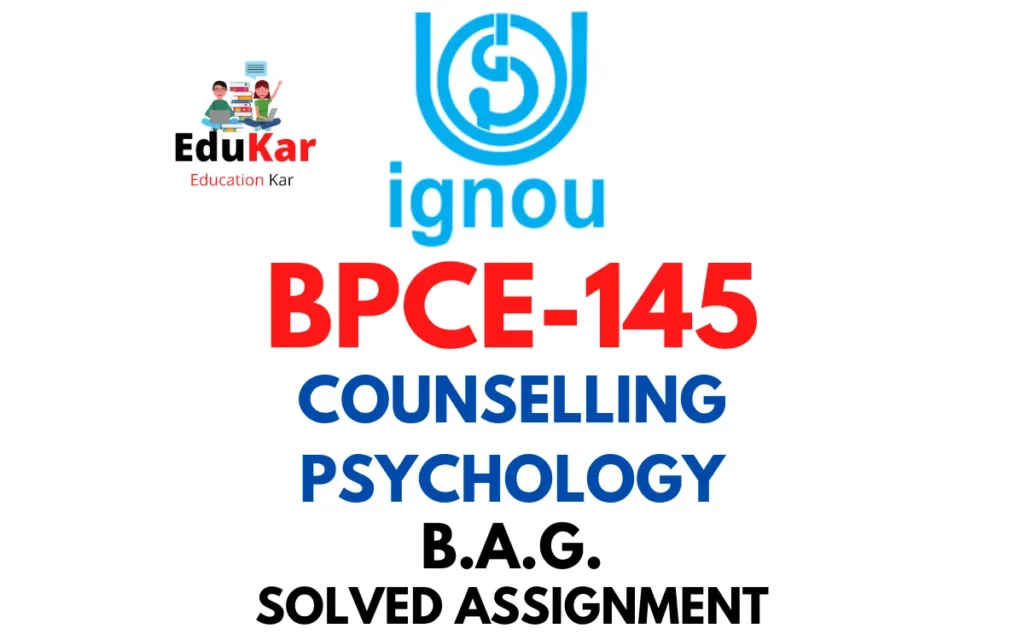



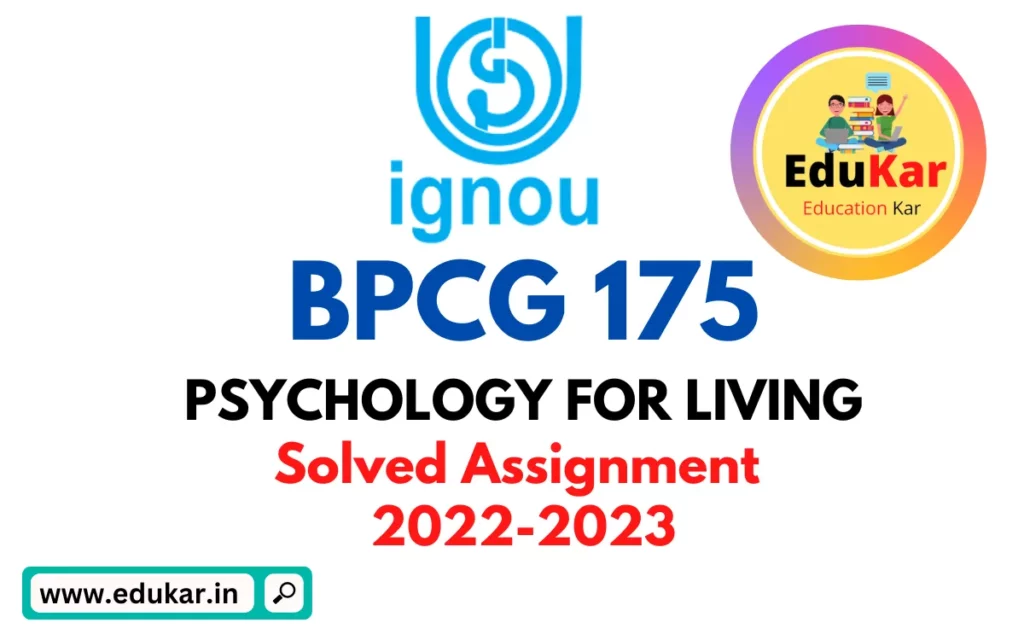


![[Solved Assignment] BPCS 185-DEVELOPING EMOTIONAL COMPETENCE (IGNOU-BAG) 2022-2023 [Solved Assignment] BPCS 185-DEVELOPING EMOTIONAL COMPETENCE (IGNOU-BAG) 2022-2023](https://edukar.in/wp-content/plugins/contextual-related-posts/default.png)

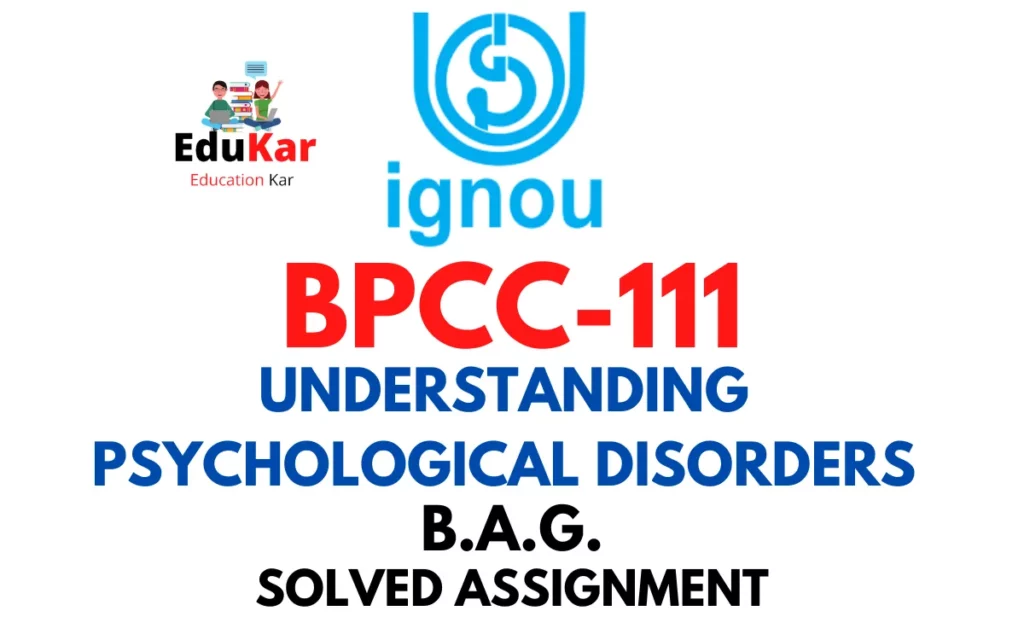
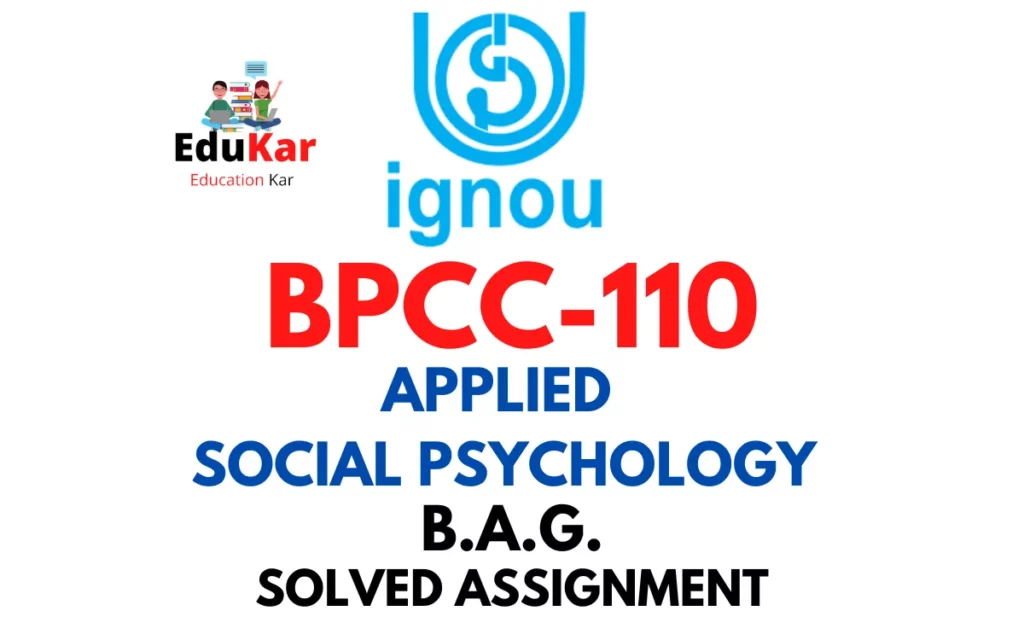


![[Solved Assignment] BPCS 188-APPLICATIONS OF SOCIAL PSYCHOLOGY (IGNOU-BAG) 2022-2023 BPCS 188-APPLICATIONS OF SOCIAL PSYCHOLOGY IGNOU BAG Solved Assignment 2022-2023](https://edukar.in/wp-content/uploads/2023/01/BPCS-188-APPLICATIONS-OF-SOCIAL-PSYCHOLOGY-IGNOU-BAG-Solved-Assignment-2022-2023-1024x640.webp)
